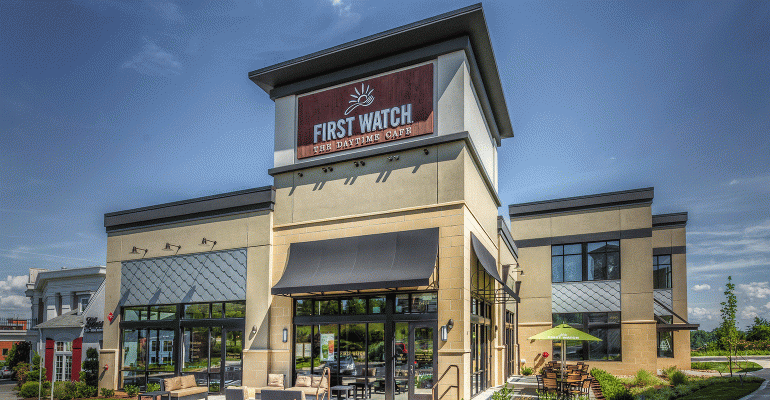First Watch provided an overview of its fourth quarter and full-year 2022 results Thursday, including a 14.2% jump in revenues – or 21.5% on the full year 2022 – and same-store sales increase of 7.7%. Same-store sales are up nearly 30% compared to the same period in 2019.
Notably, as much of the industry grapples with traffic erosion, First Watch reported a 7.7% increase in traffic growth in 2022, and a 6.5% traffic increase versus 2019. This is compared to industry-wide trends showing a traffic decline of 3% in 2022, according to CEO Chris Tomasso, citing BlackBox Intelligence data.
“To us, strong traffic share represents the truest measure of consumer appeal and the overall health of a concept,” he said during the company’s earnings call Thursday morning. Volumes, he added, are higher than they’ve ever been in the company’s 40-year history. Prior to 2022, the company’s weekly sales record was just shy of $70,000, for instance, while a restaurant that opened in November in Virginia generated $110,000 in sales in its fifth week in operation. The restaurant now sits at a weekly sales average of nearly $90,000.
“Since this record-setting opening, we’ve seen others in our 2022 vintage break that $75,000 weekly sales threshold as well. These higher sales are not an anomaly,” he said.
Tomasso added that the 29 company-owned restaurants that opened in 2022 – out of 43 overall new openings – are experiencing 7% higher average unit volumes than existing restaurants.
“These restaurants appear to be building off of those volumes as they continue to mature …. These high volumes appear to be sticky,” he said. “Considering our sales and traffic growth, our biggest opportunity is to serve more consumer-led demand, so our entire organization is focused on it.”
That “focus,” he adds, has nothing to do with “robots or ChatGPT technology, but they are transformational nonetheless.” The initiatives are focused on minimizing the company’s “look and lead” phenomenon, in which customers arrive to find a busy dining room and lengthy wait time and decide to go somewhere else.
“This is the unfulfilled demand at our doorstep that represents an outsized opportunity for us to continue to push our long-term sales and traffic growth,” Tomasso said. To get there, the company is focused on five initiatives, such as an evolving real estate strategy, including more restaurants and larger restaurants that support higher volumes.
Also, the company is enhancing back-of-house process and equipment, including the installation of double makelines in many kitchens and an investment in double dishwashers and wider griddles. The company is also in the early phases of leveraging energy-efficient smart ovens, which cook food faster and more consistently. And, kitchen display systems were rolled out to all company-owned restaurants by the end of 2022. Tomasso said the KDS is “a critical piece in driving higher throughput and setting us up to scale our goal of 2,200 domestic locations.”
In the front of the house, First Watch is testing “role specialization,” which is “leveraging more positions such as a dedicated expediter role and a dedicated beverage position to free up more time for servers.” Thus far, the test has allowed servers to serve more tables and has boosted customer satisfaction levels, Tomasso said.
First Watch is also leveraging technology to alleviate consumer pain points, including through a front of house management system. About 30% of weekend traffic flows through this system, which allows the company to track consumer behavior, better manage table turns and serve more demand, executives said.
Executives expect these initiatives to contribute to continued traffic momentum. Thus far this year, for instance, same-store sales and traffic growth are up 15.7% and 8.5%, respectively, according to CFO Mel Hope.
“We’ve broken out of the gate fast,” he said, adding that the company expects between 6% and 8% same-store sales growth this year and continued positive traffic. In addition to its aforementioned initiatives, alcohol will also likely to be a key driver of the company’s growth in the near term. About 85% of restaurants now sell alcohol, which is up slightly from Q3. The alcohol sales mix is above 6% at those restaurants.
“[Alcohol] a focus for us. Once we get it rolled out to the system, that’s when we’ll start to innovate,” Tomasso said. “You’ll start to see something there in the later part of this year.”
Tomasso added that the company is “just getting started.”
“I’ve never been more excited to be a part of this company,” he said. “We’re not paying to acquire the incremental customer. They’re knocking on our door.”
Contact Alicia Kelso at [email protected]




